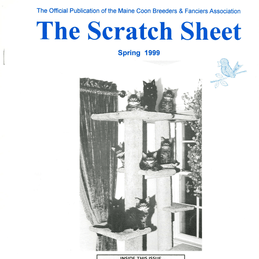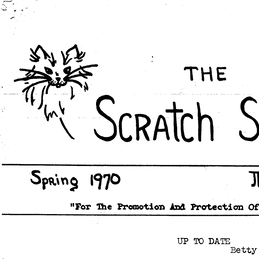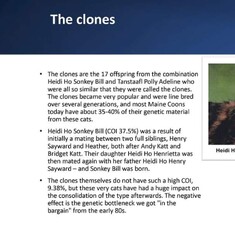MAINE COON HISTORY, MYTHS & POLYDACTYL INFO
Maine Coons come from North America. They're considered a 'natural breed', meaning they weren't intentionally human-made (like a Ragdoll, for example).
There isn't much info on where / why / how the original cats appeared. It's most likely they started out from the native cats in the Maine, New England, North Eastern American area in the mid 19th Century, hence the name. It's likely that they naturally evolved to live around various farmers' properties, scavenging on small game and vermin. As a result of natural selection, they were known as robust, muscular, working cat.
Apparently, the farmers would take their best cats (at keeping down vermin) to markets, and present them (or their offspring) to other farmers, who would purchase them for their own properties. Later this evolved into showing and domesticating them into pet / family cats.
Earlier history beyond that is sketchy / mythical. There's stories of cats travelling on Viking ships from Scandinavia. It makes sense that Norwegian Forest Cats, Siberians or Turkish Vans might contribute to the earliest lines.
Another tale is of Queen Marie Antoinette's Turkish Angora cats during the French Revolution. The queen boarded the cats on the ship when she was trying to escape, but she was captured and executed. The cats travelled to Maine, and from there, mingled with the native cat population.
There's other tales of Persian and Chinchilla cats mixing with the Northern cats which likely introduced the silver gene into their coat colours.
The most fun (but physically impossible) story is that the Native American cats mated with racoons!
Many of the cats were polydactyl, meaning they had extra digits / toes. This was thought to help with mobility in the snow / on the ships. The early show breeders tried to stamp this trait out, it was deemed undesirable / not very pretty. In recent years, it's become reaccepted into the show world in some countries, including Europe and New Zealand. The TICA standard allows for polys to be shown and bred.
The polydactyl gene has a couple of studies related to Maine Coons (poly is actually a trait found in many species, including humans, rats and birds). The studies show that in isolation, the poly gene codes for extra toes, it doesn't cause pain with this presentation, and it's unrelated to 'double-paw' or 'radial hypoplasia' aka 'twisty cat' (they're coded by different genes). It's simply the presence of extra toes - any number above the standard 5 on the front and 4 on the back). It's a naturally occurring, dominant trait. It wasn't introduced by humans. However, once we discovered it, humans did selectively breed for it sometimes.
I personally find it to be an endearing and unique trait. The only other cat that has poly included in their breed standard is the Pixie Bob. We do have poly's in our lines, and I really love them.
See below for some links to historical articles.
APPEARANCE & TEMPERAMENT
Maine Coons have double coats, with a shaggy, uneven appearance, and huge tails. The outer layer is water resistant, and keeps them warm in winter and cool in summer.
They're known as the largest domestic cat breed. They're body is long and rectangular, with a square muzzle, ear tufts/furnishings and tufted toes. They have temperaments that are very dog-like, intelligent, and trainable.
They love their humans and follow them from room to room while at home. Some are affectionate lap-cats, and others prefer to "judge" from a distance. They're quirky, often clumsy, and you'll never be alone.
Some are fascinated by water, and actually like swimming, while most of them love to play and dig in their water source.
They're very trainable, with many owners successfully harness or trick training them. If you start young, and maintain their confidence, many people take their MCs on outings on their harness. We have kittens that have been to the beach, walks in the forest, or near their homes, and out to pet friendly shops. (We can start this for you, if you're interested).
They love to be up high, so many have large, tall cat trees or shelves, where they can climb and judge you from above (haha).
They do well with toys and enrichment, and love being outdoors in secure enclosures where they can experience the sunshine, watch the birds, and play in water.
MAINE COON BREED STANDARD
"The overall impression of the Maine Coon is a large framed cat with large ears, broad chest, solid bone structure, a long, hard muscled, rectangular body and a long flowing tail. Good muscle tone and density give the cat the appearance of power and robustness. A distinctive characteristic is its smooth, shaggy coat. A natural breed of amicable character that traces its origin to the working cat found on the farms of North America." - FIFe, ACF breed standards (linked below)
In general, the breed standard aims to preserve the breed traits and known history of the breed. There are several versions of the MC breed standard, based on different global regions. This seems to have evolved over time.
Have a look here for an interesting timeline: http://mainecooninternational.com/Maine-Coon-Standards-and-their-history/
So how do we know which one to follow? It's tricky.... here in South Australia, our standard is drawn from the ACF, which is drawn from FIFe (why would anything be simple?). So at the moment, this is what we're following when we attend shows and how we're governed by our breed association GCCFSA.
GCCFSA have specifically allowed us to own, breed and sell polydactyl Maine Coons, however we cannot show them at this time. It will be interesting whether Aussie standards will eventually follow TICA and NZ with accepting polys for show. I believe that most of the US and Europeans who breed/show polys do so under TICA. Over the last year / conversations with various judges at shows we've attended, we have the support to begin making applications for showing polydactyl Maine Coons (MCP). This is important to me, because polydactyls are a natural part of the Maine Coon history. As far as we know, the trait wasn't introduced by humans, however we have selected for it over time, and I'd like to preserve that.
If you're interested, I've linked the standards from the main bodies around the world below. They're very similar, but there are some points that vary: notably, whether polydactyl paws and/or the ticked coat pattern are accepted.
BREED STANDARDS BASED ON REGION:
Australian Cat Federation - ACF standards drawn from FIFe / South Australian standard GCCFSA is based on this (as per website),
ticked colour allowed, polydactyl not mentioned
https://www.acf.asn.au/notices/notices/standards/Group%20One/Maine%20Coon-2023.pdf
NZCF (New Zealand) - allows for polydactyl
https://nzcf.com/sop/MaineCoon.pdf
TICA (Global, based in Texas) - allows for polydactyl
https://tica.org/phocadownload/mc.pdf
FIFe (Global / Europe) - ticked colour allowed, poly not mentioned
http://www1.fifeweb.org/dnld/std/MCO.pdf
An interesting breed origins conversation - The Scratch Sheet - Fall, Winter, Summer 1976
Historical references to polydactyly in MCBFA - The Scratch Sheet - Spring 1999
Polydactyly is included in the MCBFA standard - The Scratch Sheet - Spring 1970
Breed history, graphics below from:






















